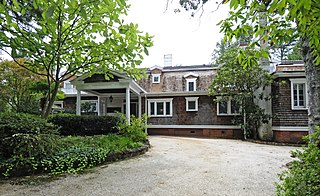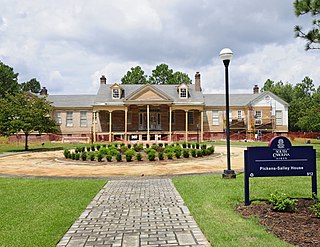
Aiken is the largest city in, and the county seat of, Aiken County, in western South Carolina, United States. It is one of the two largest cities of the Central Savannah River Area. Founded in 1835, Aiken was named after William Aiken, the president of the South Carolina Railroad. It became part of Aiken County when the county was formed in 1871 from parts of Orangeburg, Lexington, Edgefield, and Barnwell counties.

Fountain Inn is a city in Greenville and Laurens counties in the U.S. state of South Carolina. The population was 7,799 at the 2010 census, up from 6,017 in 2000. It is part of the Greenville–Mauldin–Easley Metropolitan Statistical Area.

Redcliffe Plantation State Historic Site is a state park in South Carolina, United States. Redcliffe Plantation, also known as Redcliffe, completed in 1859, is a Greek Revival plantation house located on the site that is listed on the National Register of Historic Places. The house was designed by the baron Louis Berckmans and was built in 1857. It was built for James Henry Hammond and was home to three generations of his descendants. His great-grandson John Shaw Billings, editor of Time, Life, and Fortune magazines, donated the estate and collections to the people of South Carolina in 1973. The same year it was added to the National Register of Historic Places.

Poinsett Bridge is the oldest bridge in South Carolina and perhaps in the entire southeastern United States. Named for Joel Roberts Poinsett, it was built in 1820 as part of a road from Columbia, South Carolina, to Saluda Mountain. The stone bridge, which includes a 14-foot (4.3 m) Gothic arch and stretches 130 feet (40 m) over Little Gap Creek, may have been designed by Robert Mills, architect of the Washington Monument. Though no longer in use, the bridge remains largely intact and is part of the 120-acre (48.6 ha) Poinsett Bridge Heritage Preserve. There is a nature trail a few hundred yards from the bridge.The bridge, about which ghost stories have been told for decades, is located off U.S. Highway 25 north of Greenville, South Carolina. The bridge was added to the National Register of Historic Places in 1970.

The Gov. William Aiken House was built in 1820 at 48 Elizabeth Street, in the Wraggborough neighborhood of Charleston, South Carolina. Despite being known for its association with Gov. William Aiken, the house was built by John Robinson after he bought several lots in Mazyck-Wraggborough in 1817. His house was originally configured as a Charleston single house with entrance to the house from the south side along Judith Street. The house is considered to be the best preserved complex of antebellum domestic structures in Charleston. It was the home of William Aiken, Jr., a governor of South Carolina, and before that the home of his father, the owner of South Carolina Canal and Railroad Company, William Aiken.

The Cedars, also known as Ardis House or Atkinson House, is a house in Beech Island, South Carolina. It was listed on the U.S. National Register of Historic Places in 1993.

Broad Margin is the name given to the private residence originally commissioned by Gabrielle and Charlcey Austin. It is located in Greenville, South Carolina, United States, was designed by Frank Lloyd Wright and was built by local builder Harold T. Newton in 1954. It is one of two buildings designed by Wright in South Carolina.

Paris Mountain State Park is a state park in the U.S. state of South Carolina, located five miles (8 km) north of Greenville. Activities available in the 1,540-acre (6 km2) park include hiking, biking, swimming and picnicking. The 13-acre (52,609 m2) Lake Placid offers swimming and fishing. Canoes, kayaks, and pedal boats are seasonally available for rental; private boats are not permitted. Camping is allowed and campsites range from rustic, back country sites to paved sites with water and electricity hook-ups. The park's Civilian Conservation Corps (CCC) structures, including the Camp Buckhorn lodge, are listed on the National Register of Historic Places. m.
Aiken House may refer to:

Chinaberry, also known as Williams-Converse House, is a house in Aiken, South Carolina that was built in 1824. It was listed on the National Register of Historic Places in 1982.

Stradley and Barr Dry Goods Store in Greenville, South Carolina was listed on the National Register of Historic Places in 2008.

Greenville Presbyterian Church is a historic Presbyterian church located near Donalds, Greenwood County, South Carolina. It was built in 1852 and is a meeting house form, Greek Revival style brick church. Also on the property are a small brick Session House, a large historic cemetery containing about 1,200 identifiable graves, and a natural spring. The earliest graves in the church cemetery date from 1777 and numerous markers indicate service in the American Revolution and American Civil War.

The Dawson-Vanderhorst House, located in Aiken, South Carolina. The house is one of the oldest remaining homes in Aiken County. In 1785, Charles Richmond acquired the property by grant. Shortly thereafter it appears that the home was built. There are a number of architectural features to the home that are representative of the time period in which it was built. The rear extensions to the home are not thought to be part of the original construction. The home is on private property surrounded by tall trees and brush. The Dawson-Vanderhorst House was listed on the National Register of Historic Places on June 29, 1976.

Joye Cottage is one of the oldest, and largest winter retreats in Aiken, South Carolina. Most of the sprawling property dates to 1897, when William Collins Whitney purchased the property and remodeled it extensively. It now includes a main house, a stable, a greenhouse, a laundry house, a couple of one-story cottages, and a squash court. The property was listed on the National Register of Historic Places in 1980.

The Legare-Morgan House is a one-story clapboard structure built in Aiken, South Carolina around 1835. From 1850 to 1859 it was the home of the artist, poet and inventor, James Mathews Legare. In 1870 the property was sold to Thomas C. Morgan. The home, located in proximity to Aiken's downtown area, was listed on the National Register of Historic Places September 22, 1977.

The Phelps House, is located in Aiken, South Carolina. The house was built in the early 1900s on the foundations of an antebellum house that had been destroyed during the Civil War. It is historically significant for several reasons, one of which is its very distinctive Shingle Style. This style, used often in the late 1800s and early 1900s in the resort homes of the rich, was rarely used in South Carolina. The large house has over 20 rooms, and the grounds include the stables, garage, greenhouses and kennels. As of 2012, the home is available for commercial purposes and due to this use, can be readily viewed and enjoyed. It was listed in the National Register of Historic Places on June 10, 1974.

The Pickens House, located in Aiken, South Carolina. It is reputed to have been built around 1829 by Governor Andrew Pickens for his son. In addition, the home is also noted for its early 19th century backcountry plantation architecture. Eventually the house was abandoned, and in 1929 it was moved from its original address near Edgefield to Aiken by a leading Aiken businesswoman and strong proponent of women's rights, Eulalie Chafee Salley. Around 1990 the home was again moved, this time to the campus of the University of South Carolina at Aiken. Much renovation work was taking place in the summer of 2012. The Pickens House was listed on the National Register of Historic Places on May 19, 1983.

The Charles E. Simons Jr. Federal Court House is located in Aiken, South Carolina. It is significant for its association with the many federal construction programs of the Great Depression era. The building, designed by Columbia, South Carolina architects Lafaye and Lafaye, is an excellent example of a Georgian Revival building, a style often used during the 1920s and 1930s for government buildings in smaller towns. The Court House was listed in the National Register of Historic Places on December 10, 2003.

T. Q. Donaldson House, also known as the Dr. Davis Furman House, is a historic home located at Greenville, South Carolina. It was built about 1863, and is a two-story, frame, vernacular Italianate style cottage. It consists of a two-story rectangular block with a one-story wing and one-story rear ells. Also on the property is a contemporary three-room frame, weatherboard outbuilding built for use as a kitchen and servant's quarters. It was built by William Williams for Thomas Q. Donaldson, a lawyer and member of the South Carolina Senate from Greenville County from 1872 to 1876.

The Lanneau-Norwood House is a historic, late 19th-century house on Belmont Avenue in Greenville, South Carolina. The house is an outstanding example of Second Empire architecture in the American South and is one of the last surviving Victorian-era homes in Greenville. The property was added to the National Register of Historic Places in 1982.























